When I’m gearing up for a kayaking adventure, one important aspect I keep in mind is what shoes to wear kayaking. There’s more to this decision than simply choosing a pair of shoes. After all, the right footwear plays a vital role in ensuring your experience on the water is comfortable, safe, and enjoyable.
Several factors come into play when making this decision, such as the type of kayaking I’ll be doing, expected weather conditions, and the terrain I’ll encounter. With these in mind, I can confidently choose the proper shoes that will provide the necessary grip, support, and protection needed while kayaking.
So, let’s dive into the subject and explore the options available for kayaking footwear. Keeping comfort, safety, and suitability at the forefront, we’ll tackle the different shoe styles that will give you the best kayaking experience.
Contents
Contents
Assessing Your Kayaking Environment
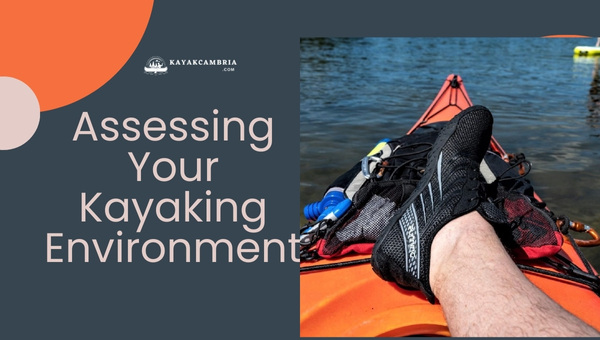
Before deciding what shoes to wear kayaking, it’s crucial to assess the environment you’ll be navigating. Different kayaking locations demand varying footwear requirements. Below are a few key aspects I consider when determining the appropriate shoes for a kayaking adventure.
1. Weather Conditions
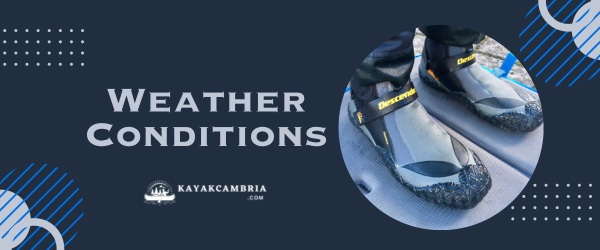
Monitoring the weather is essential in selecting the right footwear. When kayaking in warm weather, I prefer breathable, lightweight shoes that keep my feet cool. However, when facing colder temperatures, I opt for insulated, waterproof footwear that provides ample warmth.
2. Water Conditions
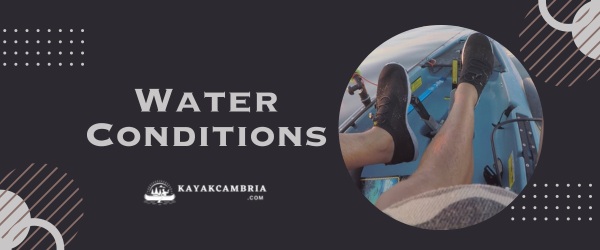
The type of water you’ll be kayaking in strongly influences your shoe choice. For calm, flat waters, a light and flexible shoe should suffice. But in more turbulent environments, such as white-water kayaking, a more robust and sturdy shoe is required for optimal foot protection.
3. Terrain

Understanding the terrain around your kayaking location helps you determine the level of foot support you need. A few common scenarios include:
- Rocky surfaces: In areas with sharp or uneven rocks, I choose footwear providing a thick, durable sole to shield my feet.
- Sandy terrain: For sandy or soft-ground locations, I prefer shoes with a thinner sole that won’t hinder my flexibility or movement.
- Slippery surfaces: When encountering slippery surfaces, I opt for shoes with excellent traction and grip to avoid any accidents.
4. Duration of Your Kayak Trip

The length of your kayaking excursion influences the type of footwear needed. For shorter trips, you might find that a lightweight, flexible option is sufficient. Longer excursions, however, typically require additional support and comfort for your feet.
5. Types of Shoes to Consider
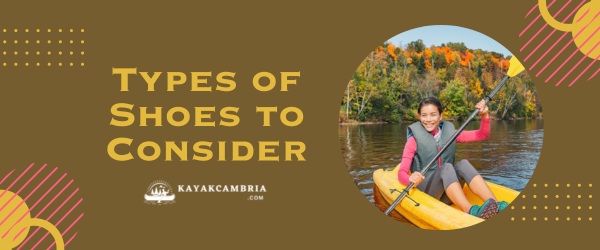
Based on these factors, some popular choices for kayaking footwear include:
- Water shoes: These lightweight shoes offer excellent breathability and flexibility. Their thin soles provide basic protection against rocks or other hazards.
- Neoprene booties: Designed specifically for water sports, these insulated booties keep your feet warm even when wet. They’re perfect for colder weather or water conditions.
- Sandals: Sturdy water sandals, such as those with rugged soles and good arch support, are a popular option for warm water kayaking.
By carefully assessing your kayaking environment, you’ll be better equipped to choose the perfect footwear for your adventure. Be sure to consider the weather, water conditions, terrain, and trip duration to make the most informed decision on what shoes to wear kayaking.
The Importance of Proper Footwear

When planning a kayaking adventure, many people wonder what shoes to wear kayaking. Choosing the right footwear is crucial, not only for comfort but also for safety. In this section, I’ll explain why it’s important to pick the proper shoes and give you some tips on finding the best fit for your kayaking needs.
First and foremost, wearing suitable shoes protects your feet. Sharp rocks, slippery surfaces, and unexpected debris can pose a risk to your feet if they aren’t adequately protected. By wearing appropriate footwear, you significantly reduce the chances of sustaining injuries, such as cuts or bruises.
Secondly, there’s the issue of comfort. Kayaking is an activity that often involves getting your feet wet. Ill-fitting or unsuitable shoes can cause discomfort, blisters, or worse, give you an unpleasant kayaking experience. Investing in a pair of shoes specifically designed for kayaking can give your feet the support and stability they need on and off the water.
Another reason to opt for proper footwear is that it provides better grip and traction. The variety of surfaces you’ll encounter on a kayaking trip can make it challenging to keep your footing, but the right shoes can help you maintain stability. Shoes designed for kayaking often feature soles that offer excellent grip on wet and slippery surfaces, which is essential for avoiding slips or falls.
Moreover, adequate footwear offers thermal protection. Depending on when and where you’re kayaking, water temperatures and weather conditions can vary significantly. Wearing shoes designed to keep your feet warm in colder environments or cool in warmer climates ensures your adventure remains enjoyable, regardless of the temperature.
Lastly, the right kayaking shoes can enhance your overall performance. Footwear that fits well and provides ample support enables you to put more power into your paddle strokes, making each movement more efficient and effective.
Should My Kayaking Footwear Be Waterproof?
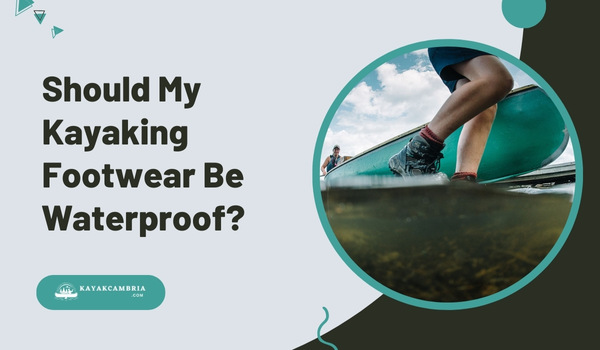
As an avid kayaker, I always look forward to the exhilaration of gliding through the water and exploring new landscapes. My kayak feels like an extension of myself as I navigate rivers, lakes, or even open ocean environments. One question that often arises in the minds of all kayaking enthusiasts is what kind of footwear they should wear, and whether it should be waterproof or not. In my opinion, based on my experience and research, the answer is a resounding yes – my kayaking footwear should be waterproof.
Here’s why I believe waterproof footwear is a necessity while kayaking.
1. Protection from water and wet environments
As one might expect, kayaking involves direct contact with water, almost guaranteeing that your feet will get wet during your adventure. Wearing waterproof footwear helps me keep my feet dry and comfortable, and prevents annoying and potentially painful issues like blisters, chafing, or soggy socks. By choosing waterproof shoes, I can focus on enjoying my time on the water, rather than being distracted by the inconveniences caused by wet feet.
2. Improved traction and grip
When I kayak, I often find myself stepping on slippery surfaces – both in and out of the water. Waterproof shoes are typically designed with materials that provide better traction and grip, helping me maintain my balance and prevent accidents on wet surfaces, such as docks, rocks, or muddy riverbanks. This is particularly beneficial for that kayaking in unpredictable environments that can quickly change from being relatively dry to completely submerged underwater.
3. Keeping feet warm
Water temperature is often lower than the air temperature, even on a sunny summer day, which can lead to uncomfortably cold feet when water seeps into my shoes. Waterproof footwear creates a barrier against cold water, keeping my feet warm and cozy throughout my kayaking excursions. This is particularly important when I am kayaking in colder seasons or climates, as it helps prevent conditions like hypothermia or frostbite.
4. Durability and support
My kayaking adventures often take me through rough landscapes with jagged rocks, sand, or sharp shells. Waterproof shoes are typically constructed with durable materials that can endure tough conditions, ensuring that my footwear will last longer. Furthermore, these shoes typically offer better arch support and cushioning, making them more comfortable for extended periods of kayaking or multiple excursions. The support and adaptability of these shoes allow me to effortlessly explore diverse terrains, without worrying about ruining my shoes or causing injury to myself.
5. Smooth transition from water to land
As I paddle my way through different environments, I often come across areas where I need to briefly step out of my kayak to scout ahead, portage, or explore on foot. Waterproof shoes make it easier for me to transition between water and land activities, without needing to change shoes or spend time dealing with wet feet.
Investing in a good quality pair of waterproof shoes for kayaking is a smart decision. It not only protects my feet from water and wet environments but also keeps them warm, provides improved traction, ensures durability and support, and simplifies the transition between water and land. This way, I can fully immerse myself in the joy of kayaking, knowing that my feet are well taken care of.
Best Shoes For Whitewater Kayaking in 2025
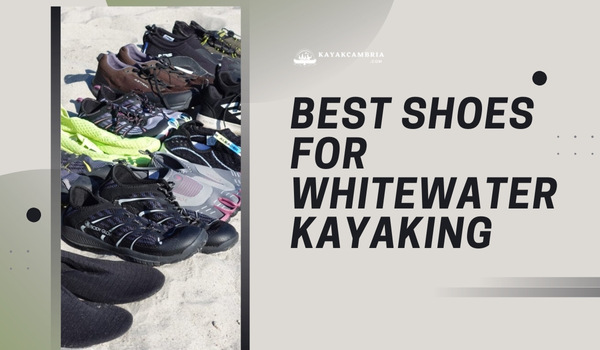
When I’m preparing to take on the thrill of whitewater kayaking, I need to be equipped with shoes that can handle the rough conditions, while still providing the necessary grip and protection. The ideal shoes for these intense kayaking sessions need to have a few specific characteristics.
- Durable and Rugged: Whitewater kayaking can be tough on my footwear, so I need something built to survive the rigors of the rapids. This means choosing shoes made from materials that can withstand rough conditions, such as neoprene, rubber, or synthetic fabrics.
- Good Grip and Traction: The last thing I want while navigating the raging waters is to lose my footing. Shoes with a sticky rubber sole are essential for providing the right kind of traction on slippery surfaces, both in and out of the kayak.
- Ankle Support: Whitewater kayaking often means entering and exiting the kayak on uneven terrain. A shoe that provides good ankle support is vital for keeping my feet and ankles safe and secure during these challenging activities.
- Drainage: As the intense rapids can quickly fill up my kayak with water, shoes that drain and dry quickly are a must-have. Look for footwear with mesh panels or drainage holes that allow water to escape and air to circulate.
- Proper Fit: A secure fit is crucial for whitewater kayaking. Shoes that are too tight can hinder circulation and cause discomfort, while those that are too loose may come off in the rapids. The right fit ensures that my shoes stay on throughout the adventure, while still allowing for flexibility and comfort.
Some of the best footwear options for whitewater kayaking include:
1. Neoprene Booties
These snug-fitting booties offer a combination of warmth, flexibility, and grip. They tend to feature reinforced soles and are great for colder water conditions.
2. Water Shoes
Lightweight and breathable, these shoes are designed specifically for water sports. They offer excellent traction and often have a secure lacing system to keep my feet comfortable and safe.
3. Amphibious Shoes
These hybrid shoes are perfect for those who want versatility. They offer great traction on both wet and dry surfaces, making them ideal for whitewater kayaking as well as hiking to and from the water.
Best Shoes For Sea Kayaking in 2025
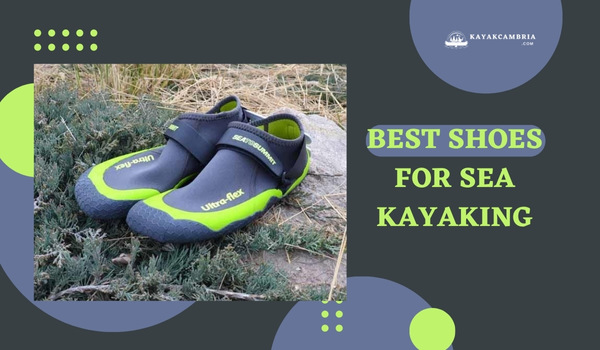
When it comes to sea kayaking, the challenges are different from those faced while whitewater kayaking. The footwear I choose needs to provide comfort and support throughout long periods of paddling and help me adjust to any unexpected changes in conditions. Here are the factors I consider when selecting the perfect shoes for sea kayaking:
- Protection Against The Elements: Sea kayaking often involves being exposed to the sun and saltwater for extended periods, which can take a toll on my feet. Shoes made from materials that resist the harsh effects of sun exposure and saltwater corrosion are crucial for durability and comfort.
- Comfort and Flexibility: Longer paddling sessions demand shoes that provide the optimum balance between comfort and support. A flexible sole allows me to maintain a natural, comfortable foot position while paddling.
- Breathability and Drainage: Sea kayaking means my feet will be submerged in water from time to time. Breathable and quick-drying shoes will keep my feet comfortable and reduce any unpleasant odors.
- Grip and Traction: When disembarking from my sea kayak onto slippery rocks or docks, I need a reliable grip for safety. Non-slip, rubberized soles are perfect for stability on wet surfaces.
Some of my top picks for sea kayaking footwear include:
1. Sandals
High-quality, closed-toe sandals made from quick-drying materials offer support, ventilation, and protection from abrasion. They’re ideal for warmer water conditions.
2. Water shoes
Just like with whitewater kayaking, water shoes also provide outstanding support, grip, and breathability during sea kayaking. They come in various designs and materials, allowing me to choose the best fit for my needs.
3. Neoprene booties
For colder water conditions, neoprene booties are perfect for sea kayaking. They provide the necessary insulation and are comfortable to wear under spray skirts.
Ultimately, the ideal shoes for sea kayaking will depend on the specific conditions of my destination and personal preferences. By considering the factors mentioned above, I can make an informed decision and enjoy my time on the water in comfort and safety.
Best Shoes For Kayaking At Lake in 2025
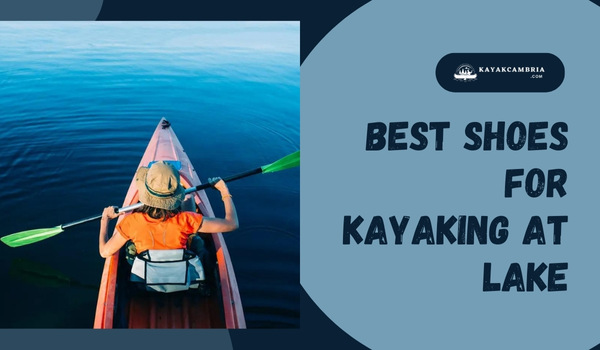
Choosing the best footwear for kayaking at a lake can be a bit different compared to sea or whitewater kayaking. Lake kayaking typically involves calm waters and possibly walking through uneven terrain at the shoreline. The key factors I consider when selecting the perfect shoes for lake kayaking are:
- Comfort and Support: As lake kayaking tends to be more leisurely, I want to make sure my footwear is comfortable for both paddling and casual walking around the shoreline.
- Grip and Traction: The ideal shoes must have excellent grip, as the shoreline and boat launches can be slippery or uneven, increasing the risk of injuries.
- Quick-Drying and Breathable: As my feet might get wet while kayaking, I prefer quick-drying shoes to avoid spending the rest of the day in damp footwear.
With those factors in mind, the following are some excellent options for lake kayaking footwear:
1. Water shoes
Water shoes continue to be a top choice for lake kayaking. They provide excellent grip, breathability, and comfort for walking in wet environments. They’re lightweight, quick-drying, and protect my feet from potential hazards.
2. Closed-toe sandals
Closed-toe sandals offer a similar blend of support, breathability, and protection as water shoes, but with a more open and airy design. High-quality sandals made from quick-drying materials are great for kayaking in warmer weather when I want my feet to stay cool and comfortable.
3. Aqua socks
Aqua socks can be perfect for lake kayaking. They’re lightweight and provide a snug fit, offering decent protection and grip. Their thin soles allow for flexibility and a more comfortable paddling experience. However, they might not be the best choice for walking long distances on rocky shores.
4. Lightweight trail shoes
For those who plan to hike or explore the surrounding area on foot, lightweight trail shoes can be a versatile choice. They offer solid support, grip, and protection while still being breathable and reasonably quick-drying.
When selecting the best footwear for lake kayaking, I must take into consideration the specific activities I plan to engage in and the terrain surrounding the lake. By assessing the comfort, support, breathability, and grip requirements, I can make an informed decision and enjoy my kayaking experience to the fullest.
Best Shoes To Wear Kayaking In Winter (2025)
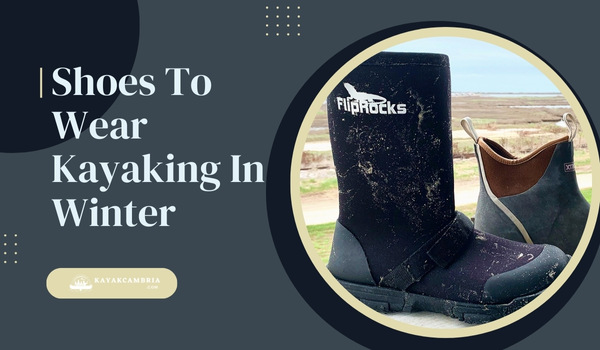
Kayaking in winter brings its unique set of challenges, and choosing the right footwear is essential to stay warm and comfortable during these colder outings. I consider the following factors when selecting shoes for kayaking during the winter months:
- Insulation: Cold water temperatures and harsh weather conditions call for well-insulated footwear. Neoprene, with its excellent thermal properties, is the preferred material for winter kayaking shoes. Depending on the water temperature, I opt for neoprene booties between 3mm and 7mm in thickness.
- Waterproofing: Snow, rain, and cold water are all part of the winter kayaking experience. Ensuring that my feet are entirely protected from water ingress is crucial, so I look for shoes offering solid waterproofing properties.
- Traction: Wet, slippery, and icy surfaces often accompany winter kayak sessions. To avoid slipping or losing balance, it’s vital to pick footwear with excellent traction and grip. Shoes with thick, non-slip rubber soles provide stability on slippery terrain.
- Fit: A snug, yet comfortable fit is essential, particularly when wearing thicker socks or additional layers for warmth. My winter kayaking shoes should accommodate these layers without being too tight, which can limit circulation and make my feet cold.
- Ankle Support: Winter kayaking footwear that offers good ankle support is essential, as it prevents injury when navigating icy or rocky terrain, especially during portages.
Based on these factors, here are some footwear options for kayaking in winter:
1. Neoprene boots
These boots, specifically designed for water sports, provide insulation and waterproofing, perfect for winter kayaking. Thicker neoprene boots (5mm-7mm) offer better insulation for colder conditions.
2. Drysuit booties
If I’m wearing a dry suit, integrated dry-suit booties made from neoprene or latex are an excellent option. They provide insulation, and waterproofing, and can be combined with additional footwear, like rubber-soled booties or water shoes, for added traction.
3. Insulated, waterproof boots
High-quality insulated, waterproof boots with non-slip soles provide warmth, protection, and grip while navigating winter conditions. Make sure they fit comfortably with all layers and don’t restrict blood flow to the feet.
Kayaking in colder conditions can still be enjoyable, provided I dress correctly from head to toe. Making the right choice in footwear is an essential first step to ensuring my winter kayaking adventures are comfortable, safe, and enjoyable.
Best Shoes To Wear Kayaking In Summer (2025)
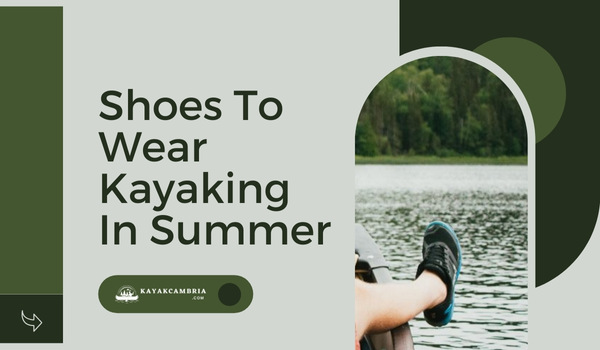
Kayaking in the summer months is an entirely different experience compared to winter kayaking. Summer kayaking shoes should prioritize breathability, quick-drying capabilities, and comfort to keep you cool and enjoying your time on the water.
When choosing shoes for kayaking during the summer, I take the following factors into account:
- Breathability: During summer, I prefer footwear that allows my feet to breathe and stay cool. Choosing shoes made from lightweight, breathable materials is critical for hot weather kayaking.
- Quick-drying: When summer kayaking, wet feet are nearly inevitable. I seek quick-drying shoes that maintain their comfort and performance even when wet.
- Drainage: Shoes with proper drainage features prevent water from pooling and weighing down your feet. This is especially important for summer kayaking, as feet are likely to be wet more often.
- Traction: Slippery surfaces still pose a risk during the summer months, so I search for shoes with good grip and non-slip soles to prevent accidents.
- Comfort: Comfort is key, especially for long kayaking sessions in the summer. I look for lightweight shoes that are easy to wear for extended periods without causing discomfort.
With that in mind, here are the best footwear options for summer kayaking:
1. Water shoes
These shoes are specifically designed for water activities, providing excellent drainage, breathability, and quick-drying capabilities. They’re typically made from lightweight, mesh materials that keep the feet cool in hot conditions.
2. Sandals
Quality water sandals, such as those with closed toes, offer a good combination of breathability, traction, and foot protection. Look for sandals with adjustable straps for a secure fit and robust, grippy soles for navigating slippery surfaces.
3. Aqua socks
Aqua socks are soft, lightweight, and minimalistic shoes designed to protect your feet from sharp objects and rough surfaces. These shoes are ideal for summer kayaking in calm and shallow waters, allowing optimum foot flexibility and breathability.
4. Mesh boat shoes
For a more casual option, mesh boat shoes provide good traction, quick-drying capabilities, and a stylish appearance. While not as protective as other options, they can still be suitable for relaxed summer kayaking on calmer waters.
Picking the right footwear is as essential during the summer as it is during the winter months. Well-ventilated, quick-drying, and comfortable shoes will make your summer kayaking experiences more enjoyable and ensure your feet stay protected while you paddle.
Closed-Toed Shoes: Pros and Cons
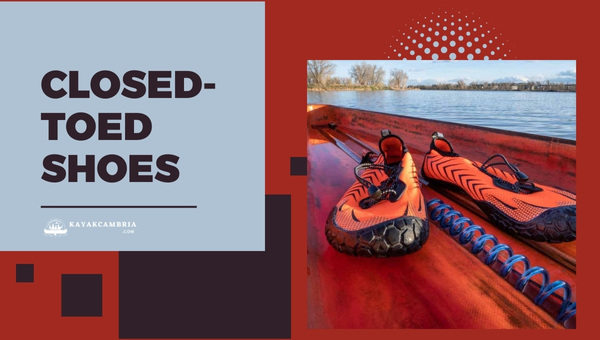
Closed-toed shoes are a popular option among enthusiasts. These shoes offer a range of benefits, as well as some drawbacks. In this section, I’ll delve into the pros and cons of closed-toed shoes, helping you decide if they’re the right fit for your kayaking adventures.
Pros
- Protection: Closed-toed shoes provide excellent protection for your feet, shielding them from sharp rocks, debris, and wildlife. This added layer of safety is crucial when traversing slippery and unpredictable terrain.
- Support: Another advantage of closed-toed shoes is the support they offer. The structured design grants stability when you need it most, especially during long hours of paddling and navigating the shoreline.
- Warmth: Thanks to their enclosed nature, closed-toed shoes help retain heat, making them a great choice for kayaking in colder conditions. Your feet are more likely to stay warm and dry, leading to a more comfortable experience.
Cons
- Drainage: Closed-toed shoes are not designed for efficient water drainage, which can lead to a soggy experience. When you’re kayaking, it’s common for water to enter your shoes, and poor drainage results in wet, heavyweight footwear.
- Drying Time: The longer it takes for shoes to dry, the less pleasant they are to wear on your next outing. Closed-toed shoes typically require more time to dry fully compared to open-toed options. This can be problematic if your kayaking trips are back-to-back, and you don’t have adequate time to let your shoes dry out.
- Bulkiness: Many closed-toed shoes are bulkier, which can make them difficult to pack and possibly less agile. For some, this added weight and reduced mobility may be a hindrance on their kayaking journey.
There are both pros and cons to consider when deciding whether closed-toed shoes are the best choice for kayaking. Prioritize the factors that matter most to you—protection, support, warmth, drainage, drying time, and bulkiness—and make an informed decision based on your personal preferences.
Water Sandals: A Breathable Option
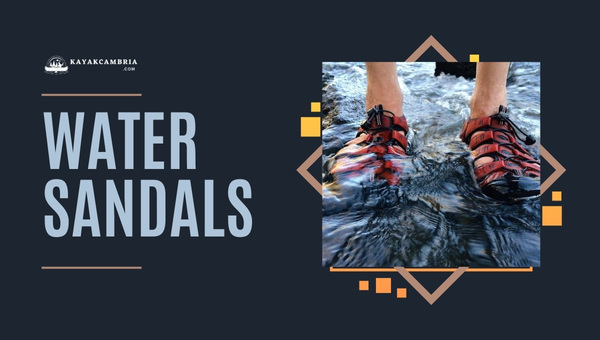
Water sandals are specifically designed to provide comfort, support, and breathability while participating in water-based activities like kayaking. In this section, I’ll discuss some of the benefits of wearing water sandals, appropriate materials, and the various types you might come across.
One of the main benefits of water sandals is their ability to dry quickly. When kayaking, your feet are bound to get wet, and you don’t want to be stuck with soggy shoes for the entire trip. Water sandals typically have open designs with drainage holes, allowing water to escape and air to flow through easily. Because of this, water sandals are an excellent choice for ensuring your feet remain comfortable while kayaking.
Another advantage of water sandals is their support and traction. A well-designed sandal will have:
- Good arch support for stability and reduced foot fatigue
- Traction-enhancing soles to prevent slips on wet surfaces
- A secure fit to keep the shoe in place during your adventure
When choosing water sandals for kayaking, it’s important to consider the materials they’re made of. Many water sandals are made with synthetic materials like:
- Neoprene: known for its insulating and water-resistant properties
- EVA (ethylene-vinyl acetate): lightweight, flexible, and comfortable
- Rubber: offers excellent traction and durability
These materials are often quick-drying, strong, and lightweight, making them well-suited for water sports like kayaking.
There are several types of water sandals available on the market, each with its advantages and features:
- Closed-toe sandals: these offer added protection for your toes.
- Open-toe sandals: allow maximum breathability and quicker drying.
- Adjustable-strap sandals: provide a more customizable and secure fit.
When considering the appropriate footwear for kayaking, water sandals are a great choice. Their breathable and quick-drying features not only keep your feet comfortable but also enhance the overall kayaking experience. Remember to consider the materials used and the type of sandal that best suits your needs to ensure a pleasant outing.
Neoprene Kayaking Boots: Ultimate Protection
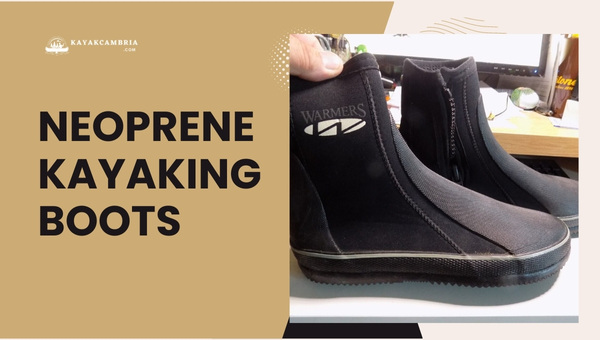
I’m a big fan of these boots due to their exceptional protection and durability. In this section, let’s dive into some key features that make neoprene kayaking boots stand out among other footwear options.
First and foremost, neoprene kayaking boots provide excellent protection for your feet while you’re kayaking. These specially-designed boots are made from neoprene, a synthetic rubber material that’s popular for its water-resistant and insulating properties. This material not only keeps your feet dry, it also helps in retaining warmth even when it’s wet. Some advantages of neoprene kayaking boots include:
- Comfort: Neoprene has a soft, flexible texture that easily conforms to the shape of your foot, providing a snug fit and all-day comfort.
- Grip: The soles of these boots are made to enhance grip on wet and slippery surfaces, which is crucial for avoiding slips and falls.
- Insulation: Neoprene’s water-resistant and insulating properties help keep your feet warm and protected, even in colder water temperatures.
- Ankle Support: You’ll find various neoprene boot styles that offer ankle support to reduce the risk of injuries as you navigate rocks and rough terrain.
When it comes to choosing the right neoprene kayaking boots, it’s important to consider factors such as size, style, and thickness. Here’s a quick summary of what to look for:
| Factor | Description |
| Size | Ensure a snug fit for optimal warmth and foot protection. |
| Style | High-cut or ankle cut boots depending on your preference. |
| Thickness | Thicker neoprene provides more insulation in colder waters. |
In addition, it’s worth considering boots with additional features, such as reinforced toe and heel caps, drainage holes, or hook-and-loop straps for added security.
Conclusion: Choosing the Right Kayaking Shoes
When it comes to deciding what shoes to wear kayaking, there are a few key factors to consider. By keeping in mind the shoe’s water resistance, traction, comfort, and material, I am able to make an informed decision that’ll best suit my kayaking adventure.
One crucial factor when selecting kayaking shoes is water resistance. Since my feet are bound to get wet while kayaking, it’s essential to choose shoes that can handle water well. Quick-drying materials can make a world of difference, helping me avoid that uncomfortable “soggy shoe” feeling throughout the day. Some popular options for water-resistant kayaking shoes include:
- Neoprene booties
- Mesh water shoes
- Rubber and synthetic sandals
Another important aspect is traction. Slippery surfaces are common when kayaking, and I need shoes with exceptional grip to avoid slips and falls. I should look for soles featuring an appropriate tread pattern and materials designed to prevent slipping, especially on wet or rocky surfaces.
Comfort is also a high priority. It’s essential for me to find shoes that provide adequate support and cushioning for a long day on the water. I need to consider how the shoes fit, if there’s enough arch support, and if they’ll remain comfortable when wet.
Lastly, the material of my kayaking shoes matters. Since the shoes will be exposed to water and rough conditions, I must select a durable material resistant to wear and tear. Footwear materials such as neoprene, rubber, and synthetic fabrics are all great choices.
So, when choosing what shoes to wear kayaking, I should focus on finding a pair that offers water resistance, traction, comfort, and durability. By considering these factors and trying on various options, I’ll be well-prepared and confident in my footwear choice for a memorable kayaking experience.

